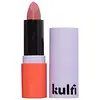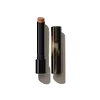What's inside
What's inside
 Key Ingredients
Key Ingredients

 Benefits
Benefits

 Concerns
Concerns

 Ingredients Side-by-side
Ingredients Side-by-side

Polyglyceryl-2 Triisostearate
EmulsifyingOctyldodecanol
EmollientBis-Diglyceryl Polyacyladipate-2
EmollientDiisostearyl Malate
EmollientSynthetic Wax
AbrasiveCaprylic/Capric Triglyceride
MaskingPolybutene
Euphorbia Cerifera Wax
Polyglyceryl-3 Diisostearate
EmulsifyingSynthetic Beeswax
Emulsion StabilisingTocopheryl Acetate
AntioxidantSilica
AbrasiveMica
Cosmetic ColorantPropylene Carbonate
SolventDisteardimonium Hectorite
StabilisingCI 77891
Cosmetic ColorantIron Oxides
CI 15850
Cosmetic ColorantCI 42090
Cosmetic ColorantPolyglyceryl-2 Triisostearate, Octyldodecanol, Bis-Diglyceryl Polyacyladipate-2, Diisostearyl Malate, Synthetic Wax, Caprylic/Capric Triglyceride, Polybutene, Euphorbia Cerifera Wax, Polyglyceryl-3 Diisostearate, Synthetic Beeswax, Tocopheryl Acetate, Silica, Mica, Propylene Carbonate, Disteardimonium Hectorite, CI 77891, Iron Oxides, CI 15850, CI 42090
Polyglyceryl-3 Diisostearate
EmulsifyingDiisostearyl Malate
EmollientBis-Diglyceryl Polyacyladipate-2
EmollientPentaerythrityl Tetraisostearate
EmollientCaprylic/Capric Triglyceride
MaskingSynthetic Wax
AbrasiveTriisostearin
Skin ConditioningPolybutene
Euphorbia Cerifera Wax
Helianthus Annuus Seed Wax
Skin ConditioningRosa Damascena Flower Wax
MaskingSimmondsia Chinensis Seed Oil
EmollientRosa Canina Fruit Oil
EmollientPunica Granatum Flower Extract
Skin ConditioningSilica
AbrasiveTocopheryl Acetate
AntioxidantPersea Gratissima Oil
Skin ConditioningCocos Nucifera Oil
MaskingDicalcium Phosphate
AbrasiveMica
Cosmetic ColorantTitanium Dioxide
Cosmetic ColorantIron Oxides
CI 19140
Cosmetic ColorantCI 15850
Cosmetic ColorantCI 42090
Cosmetic ColorantCI 47005
Cosmetic ColorantCI 15985
Cosmetic ColorantCI 45410
Cosmetic ColorantCI 77742
Cosmetic ColorantPolyglyceryl-3 Diisostearate, Diisostearyl Malate, Bis-Diglyceryl Polyacyladipate-2, Pentaerythrityl Tetraisostearate, Caprylic/Capric Triglyceride, Synthetic Wax, Triisostearin, Polybutene, Euphorbia Cerifera Wax, Helianthus Annuus Seed Wax, Rosa Damascena Flower Wax, Simmondsia Chinensis Seed Oil, Rosa Canina Fruit Oil, Punica Granatum Flower Extract, Silica, Tocopheryl Acetate, Persea Gratissima Oil, Cocos Nucifera Oil, Dicalcium Phosphate, Mica, Titanium Dioxide, Iron Oxides, CI 19140, CI 15850, CI 42090, CI 47005, CI 15985, CI 45410, CI 77742
Ingredients Explained
These ingredients are found in both products.
Ingredients higher up in an ingredient list are typically present in a larger amount.
This ingredient is lipid-based synthetic skin-conditioning agent derived from adipic acid and a mixture of fatty acids. It is often called a lanolin substitute.
As an emollient, it helps soften and hydrate the skin. Emollients create a barrier on the skin to trap moisture in.
Due to its fatty acid base, it may not be Malassezia folliculitis safe.
Learn more about Bis-Diglyceryl Polyacyladipate-2This ingredient is an emollient, solvent, and texture enhancer. It is considered a skin-softener by helping the skin prevent moisture loss.
It helps thicken a product's formula and makes it easier to spread by dissolving clumping compounds.
Caprylic Triglyceride is made by combining glycerin with coconut oil, forming a clear liquid.
While there is an assumption Caprylic Triglyceride can clog pores due to it being derived from coconut oil, there is no research supporting this.
Learn more about Caprylic/Capric TriglycerideCi 15850 is the pigment color red. It is an azo dye and created synthetically.
Azo dyes need to be thoroughly purified before use. This allows them to be more stable and longer-lasting.
This ingredient is common in foundations, lipsticks, and blushes. This color is described as brown/orangey red.
It has many secondary names such as Red 6 and Red 7. According to a manufacturer, Red 6 usually contains aluminum.
Learn more about CI 15850Ci 42090 is a synthetic dye created from petroleum. It is used to give a bright blue color to cosmetics, medicine, and food.
Diisostearyl Malate is an emollient and most often used in lip products. It comes from isostearyl alcohol, a fatty acid, and malic acid, an AHA.
As an emollient, Diisostearyl Malate helps create a thin film on your skin to trap moisture in. This helps keep your skin soft and smooth.
Mica is a naturally occurring mineral used to add shimmer and color in cosmetics. It can also help improve the texture of a product or give it an opaque, white/silver color.
Serecite is the name for very fine but ragged grains of mica.
This ingredient is often coated with metal oxides like titanium dioxide. Trace amounts of heavy metals may be found in mica, but these metals are not harmful in our personal products.
Mica has been used since prehistoric times throughout the world. Ancient Egyptian, Indian, Greek, Roman, Aztec, and Chinese civilizations have used mica.
Learn more about MicaPolybutene is used to help control the viscosity of a product. This just means it helps adjusts the texture.
It is a polymer and does not get absorbed into the skin due to its large size.
Studies found this ingredient did not irritate skin in concentrations below 15%.
Learn more about PolybutenePolyglyceryl-3 Diisostearate is an emulsifer and emollient. It comes from Isostearic Acid and Polyglycerin-3.
As an emulsifier, it helps stabilize products by preventing oils and water from separating.
This ingredient may not be Malassezia folliculitis, or fungal acne safe.
Learn more about Polyglyceryl-3 DiisostearateSilica, also known as silicon dioxide, is a naturally occurring mineral. It is used as a fine, spherical, and porous powder in cosmetics.
Though it has exfoliant properties, the function of silica varies depending on the product.
The unique structure of silica enhances the spreadability and adds smoothness, making it a great texture enhancer.
It is also used as an active carrier, emulsifier, and mattifier due to its ability to absorb excess oil.
In some products, tiny microneedles called spicules are made from silica or hydrolyzed sponge. When you rub them in, they lightly polish away dead skin layers and enhance the penetration of active ingredients.
Learn more about SilicaSynthetic Wax is created from fossil fuels such as natural gas. It is used to enhance texture, adjust pH, and as an occlusive.
It may also be used as an abrasive ingredient to exfoliate the skin.
Synthetic Wax may not be fungal acne safe.
Learn more about Synthetic WaxTocopheryl Acetate is AKA Vitamin E. It is an antioxidant and protects your skin from free radicals. Free radicals damage the skin by breaking down collagen.
One study found using Tocopheryl Acetate with Vitamin C decreased the number of sunburned cells.
Tocopheryl Acetate is commonly found in both skincare and dietary supplements.
Learn more about Tocopheryl AcetateEuphorbia Cerifera wax comes from a shrub in Northern Mexico. It is used to stabilize formulations and has emollient properties.
Emollients form a thin layer on top of skin to prevent water from evaporating, keeping skin and lips hydrated.
According to a manufacturer, this wax can range from a yellow/brown color to translucent.
Learn more about Euphorbia Cerifera WaxThis ingredient is a combination of red, black, and yellow iron oxide pigments. This combination of colors is usually found in foundation, because it results in a "skin" color.